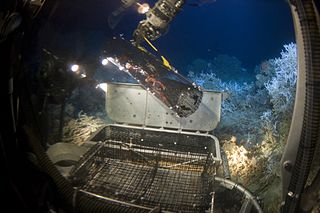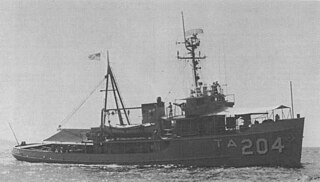There have been two US Navy ships called Trieste:
- (DSV-0) Bathyscaphe Trieste
- (DSV-1) Bathyscaphe Trieste II
There was also reference to a starship USS Trieste on Star Trek: The Next Generation.
There have been two US Navy ships called Trieste:
There was also reference to a starship USS Trieste on Star Trek: The Next Generation.

Trieste is a Swiss-designed, Italian-built deep-diving research bathyscaphe which reached a record depth of about 10,911 metres (35,797 ft) in the Challenger Deep of the Mariana Trench near Guam in the Pacific. On 23 January 1960, Jacques Piccard and US Navy Lieutenant Don Walsh achieved the goal of Project Nekton. It was the first crewed vessel to reach the bottom of the Challenger Deep.

Alvin (DSV-2) is a crewed deep-ocean research submersible owned by the United States Navy and operated by the Woods Hole Oceanographic Institution (WHOI) in Woods Hole, Massachusetts. The vehicle was built by General Mills' Electronics Group in Minneapolis, Minnesota. Named to honor the prime mover and creative inspiration for the vehicle, Allyn Vine, Alvin was commissioned on 5 June 1964. The submersible is launched from the deep submergence support vessel RV Atlantis (AGOR-25), which is also owned by the U.S. Navy and operated by WHOI. The submersible has made more than 5,000 dives, carrying two scientists and a pilot, to observe the lifeforms that must cope with super-pressures and move about in total darkness, as well as exploring the wreck of Titanic. Research conducted by Alvin has been featured in nearly 2,000 scientific papers.

A bathyscaphe is a free-diving self-propelled deep-sea submersible, consisting of a crew cabin similar to a bathysphere, but suspended below a float rather than from a surface cable, as in the classic bathysphere design.

A submersible is a small watercraft designed to operate underwater. The term submersible is often used to differentiate from other underwater vessels known as submarines, in that a submarine is a fully autonomous craft, capable of renewing its own power and breathing air, whereas a submersible is usually supported by a surface vessel, platform, shore team or sometimes a larger submarine. In common usage by the general public, however, the word submarine may be used to describe a craft that is by the technical definition actually a submersible. There are many types of submersibles, including both crewed and uncrewed craft, otherwise known as remotely operated vehicles or ROVs. Submersibles have many uses worldwide, such as oceanography, underwater archaeology, ocean exploration, adventure, equipment maintenance and recovery, and underwater videography.

A midget submarine is any submarine under 150 tons, typically operated by a crew of one or two but sometimes up to six or nine, with little or no on-board living accommodation. They normally work with mother ships, from which they are launched and recovered and which provide living accommodation for the crew and support staff.
X2 may refer to:

A deep-submergence vehicle (DSV) is a deep-diving crewed submarine that is self-propelled. Several navies operate vehicles that can be accurately described as DSVs. DSVs are commonly divided into two types: research DSVs, which are used for exploration and surveying, and DSRVs, which can be used for rescuing the crew of a sunken navy submarine, clandestine (espionage) missions, or both. DSRVs are equipped with docking chambers to allow personnel ingress and egress via a manhole.

Trieste II(DSV-1) was the successor to Trieste—the United States Navy's first bathyscaphe purchased from its Swiss designers.

Turtle (DSV-3) is a 16-ton, manned deep-ocean research submersible owned by the United States Navy. It is sister to Alvin (DSV-2), and also an Alvin class deep-submergence vehicle.
DSV-4 is a 25-ton, manned deep-ocean research submersible owned by the United States Navy, now known only by its hull number, not by its former name.

The FNRS-2 was the first bathyscaphe. It was created by Auguste Piccard. Work started in 1937 but was interrupted by World War II. The deep-diving submarine was finished in 1948. The bathyscaphe was named after the Belgian Fonds National de la Recherche Scientifique (FNRS), the funding organization for the venture. FNRS also funded the FNRS-1 which was a balloon that set a world altitude record, also built by Piccard. The FNRS-2 set world diving records, besting those of the bathyspheres, as no unwieldy cable was required for diving. It was in turn bested by a more refined version of itself, the bathyscaphe Trieste.

The FNRS-3 or FNRS III is a bathyscaphe of the French Navy. It is currently preserved at Toulon. She set world depth records, competing against a more refined version of her design, the first bathyscaphe Trieste. The French Navy eventually replaced her with the bathyscaphe FNRS-4, in the 1960s.
Trieste is a city in Italy.

Deep-sea exploration is the investigation of physical, chemical, and biological conditions on the sea bed, for scientific or commercial purposes. Deep-sea exploration is considered a relatively recent human activity compared to the other areas of geophysical research, as the depths of the sea have been investigated only during comparatively recent years. The ocean depths still remain a largely unexplored part of the planet, and form a relatively undiscovered domain.

The second USS Wandank (ATA-204), originally USS ATA-204, was a United States Navy auxiliary ocean tug in commission from 1945 to 1947 and again from 1952 to 1971. The ship is possibly best known for supporting scientific operations in the Marianas, in particular serving as communication relay and support ship for the bathyscaphe Trieste in Project Nekton; she towed the bathyscaphe some 260 nautical miles from Guam to the vicinity of the Challenger Deep, where, on 23 January 1960, Trieste descended to a record 10,911 metres.

USS White Sands (ARD-20), ex-USS ARD-20, ex-USS ARD(BS)-20, later AGDS-1, was a United States Navy auxiliary repair dock in service from 1944 to 1947 and from 1966 to 1974 and an Auxiliary floating drydock.

Project Nekton was the codename for a series of very shallow test dives and also deep-submergence operations in the Pacific Ocean near Guam that ended with the United States Navy-owned research bathyscaphe Trieste entering the Challenger Deep, the deepest surveyed point in the world's oceans.

The bathyscaphe Archimède is a deep diving research submersible of the French Navy. It used 42,000 US gallons (160,000 l) of hexane as the gasoline buoyancy of its float. It was designed by Pierre Willm and Georges Houot. In 1964, Archimède descended into "what was then thought to be the deepest part of the Puerto Rico Trench", which the NY Times reported as 27,500 feet (8,400 m). On 21 December 2018, a dive by Victor Vescovo in the DSV Limiting Factor found the "true bottom" of the Atlantic Ocean to be 27,480 feet (8,380 m), in the first manned descent to the deepest "verified bottom" of the Atlantic Ocean.

The Shinkai (しんかい) is a manned research submersible that can dive up to a depth of 600 m. It was completed in 1970, and until 1981 it had the greatest depth range of any manned research vehicle in Japan. The Shinkai is owned and run by the Japan Coast Guard and it is launched from the support vessel Otomemaru (乙女丸).

Jiaolong is a Chinese crewed deep-sea research submersible that can dive to a depth of over 7,000 metres (23,000 ft). It has the second-greatest depth range of any crewed research vehicle in the world; the only crewed expeditions to have gone deeper were the dives of the Trieste bathyscaphe in 1960, Archimède in 1962, Deepsea Challenger in 2012, and DSV Limiting Factor in 2019.